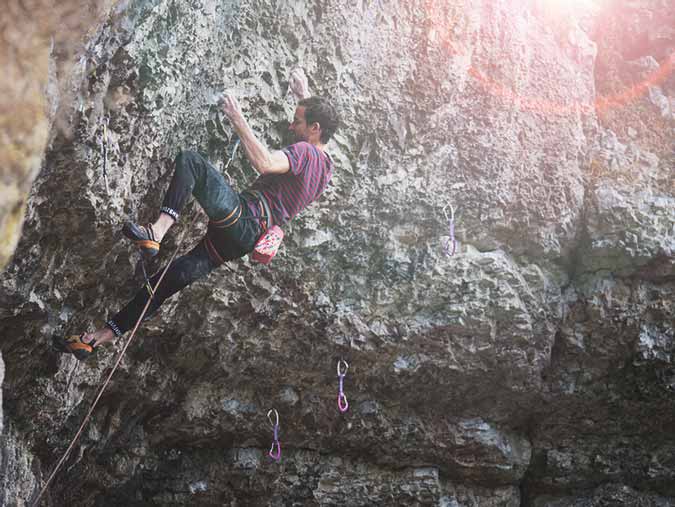
Ben Moon attempting The Bastard, the hardest route at Rubicion. The only consensus on the grade is that it’s harder than the 8c it was originally given. The line of quickdraws behind marks the line of Truly Awesome a popular 7a+ and Rubicon is the crack line just to the right.
Rubicon has long been a favourite place for Peak climbers. Situated in a beautiful sunny location on the edge of a lake and just 5 minutes from the car, it’s rarely wet. There’s a mix of bouldering and route climbing which varies from fierce crimping to full on roof climbing. The climbing style is rather more brutal than beautiful but there’s wide grade range and the rock is mostly pretty solid. The crag gets its name from the classic roof route Rubicon, which after decades of ascents no longer sheds holds at same rate as when it was first climbed back in 1979 as an E2.
History
The crag has long been a forcing ground for top climbers. In 1981 a number of hard, often bold climbs were established by Ron Fawcett, Andy Barker, and the Lee brothers, Dominic and Daniel. At the time these were some of the hardest routes in the country. Dominic Lee’s route, The Angler, was 7c in modern grades. But it’s an extremely bouldery one that still stops many good climbers today.
By 1986 sport climbing had taken a grip in the UK and Tony Ryan climbed the Peak’s second 8a+ with Caviar (after Jerry Moffatt’s Revelations the previous year). Caviar was perhaps Rubicon’s first sport route so pointed to the future both difficulty and style. The next year, 1987, Ben Moon established Zeke the Freak, the UK’s first 8b.
In 1995 John Welford climbed The Bastard. This line had had ‘all’ its holds chipped off by an aid climber who wanted it to remain an aid climb forever. He named it provacatively Free that you Bastards. When Welford free climbed the line he graded it 8c. Today, despite numerous attempts, it’s seen only one repeat in more than a quarter of a century (yep, it was Steve McClure). So unsurprisingly it’s considered to be harder than 8c. The only question is whether it’s 8c+ or 9a. Should it turn out to be the latter it will the UK’s second 9a (after Ben Moon’s Hubble).
Conditions
Rubicon faces mainly south west so gets plenty of sun. It stays mostly dry after rain although persistant wet weather will make some parts of it wet eventually through seepage and run off.
In warm weather you need an early start to escape the sun although the Rubicon sector remains shady for longer having a more westly aspect and shelter by the roofs, trees and foliage.
It’s possible to climb at Rubicon all through the winter and it’s rare when you can’t find anything dry. The Rubicon sector tends to stay mostly dry although can be made wet occasionally by condensation from mist. The Honeymoon Blues area also tends to stay mostly dry too though when raining the tops on some routes get wet. The main wall gets wet in stages and the darker patches of rock roughly match the bits that get wet first.
Approach
Lying at the western end of the dale the crag is less than 5 minutes from the road. Park at Cressbrook Mill and go through the old mill (now flats) to pick up the path on the right. Follow this across a small footbridge and arrive beneath the classic roof route of Rubicon and the righthand end of the crag.
Access
The BMC sign reads:
Climbing is allowed on Rubicon Wall and the rest of Water Cum Jolly as a concession by Cressbrook and Litton Flyfishers club who are the landowners. Climbers should therefore please avoid impeding anglers who use this stretch of water, who pay a significant amount to do so, as well as the bailiffs who visit this site regularly. The route Rubicon itself and adjacent routes should be avoided while angling is taking place in front of it (sic).
Thank you. British Mountaineering Council.
In reality it’s rare to see either anglers or bailiffs here. However the area is very popular with walkers and tourists. So more relevant advice is: Please be careful and considerate with your language as this is area is popular walkers and any inappropriate actions could cause access problems for the future.